应用集成-在Hexo、Hugo博客框架中使用Gitalk基于Github上仓库项目的issue无后端服务评论系统实践
设为「特别关注」每天带你玩转网络安全运维、应用开发、物联网IOT学习!
希望各位看友【关注、点赞、评论、收藏、投币】,助力每一个梦想。

本章目录
作者: WeiyiGeek [唯一极客]
首发地址: https://mp.weixin.qq.com/s/2LLVDf7Fj4cX3IRZUtUfnA
原文地址: https://blog.weiyigeek.top/2022/5-28-588.html
0x00 Gitalk - 基于Github的评论系统
描述: 我想对于所有使用hexo、Hugo或者WordPress自建博客的博主来说GitTalk应该不陌生,GitTalk通过Github的OpenAPI以及issues功能实现社区评论确实还是很方便的,除开对国内访问速度较慢就没啥毛病,但是考虑到新手朋友此处还是简单介绍一下。
1.快速介绍
描述: Gitalk 是一个基于 Github Issue 和 Preact 的现代评论组件。
功能:
- 使用 github 帐号进行身份验证
- 无服务器,所有评论将存储为 github 问题
- 个人和组织的github项目都可以用来存储评论
- 本地化,支持多国语言 [en, zh-CN, zh-TW, es-ES, fr, ru, de, pl, ko, fa, ja]
- 类似 Facebook 的无干扰模式(可以通过 DistentionFreeMode 选项启用)
- 热键提交评论(cmd|ctrl + enter)
项目地址:https://github.com/gitalk/gitalk
帮助文档:https://github.com/gitalk/gitalk/blob/master/readme-cn.md
温馨提示: 当前 Gitalk 最新版本为 1.7.2 (Mar 3, 2021), 如后续随着时间推移,可能会有些许变化,建议参考官网(https://github.com/gitalk/gitalk/tags)
2.安装部署
描述:安装引用Gitalk评论系统的两种方式,
安装实践
- 方式1.在你的HTML页面中使用 link 与 script 标签引入。
<link rel="stylesheet" href="https://cdn.jsdelivr.net/npm/gitalk@1/dist/gitalk.css">
<script src="https://cdn.jsdelivr.net/npm/gitalk@1/dist/gitalk.min.js"></script>
<!-- or -->
<link rel="stylesheet" href="https://unpkg.com/gitalk/dist/gitalk.css">
<script src="https://unpkg.com/gitalk/dist/gitalk.min.js"></script>
- 方式2.使用 npm 安装 gital 模块。
# 模块安装
npm i --save gitalk
# 项目导入
import 'gitalk/dist/gitalk.css'
import Gitalk from 'gitalk'
配置实践
首先,您需要为商店评论选择一个公共 github 存储库(已存在或创建一个新存储库),然后创建一个 GitHub 应用程序,如果你没有,点击这里 (https://github.com/settings/applications/new) 注册一个新的。
Application name : BlogTalk
Homepage URL : https://blog.weiyigeek.top
Application description : 欢迎访问 WeiyiGeek blog\'s [blog.weiyigeek.top] talk about , 欢迎留言骚扰哟,亲!
Authorization callback URL : https://blog.weiyigeek.top
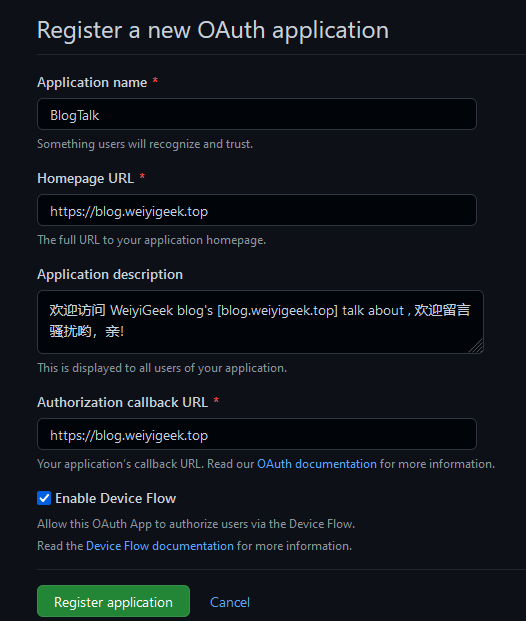
注意:您必须在授权回调 URL 字段中指定网站域 url。
然后,创建完成后你将获取Client ID 与 Client Secret,如下所示:
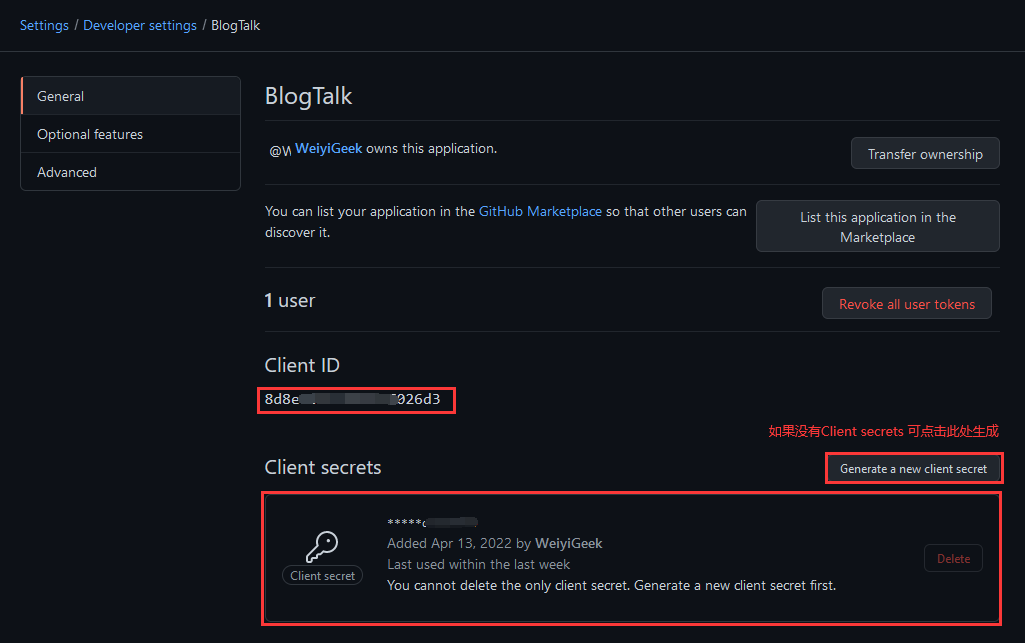
注意:后续更新修改可以进行访问 Settings/Developer settings ( https://github.com/settings/developers )
最后,创建一个公共仓库此处我创建的是blogtalk,创建完后在项目的(https://github.com/WeiyiGeek/blogtalk/settings)中启用 issue 即可
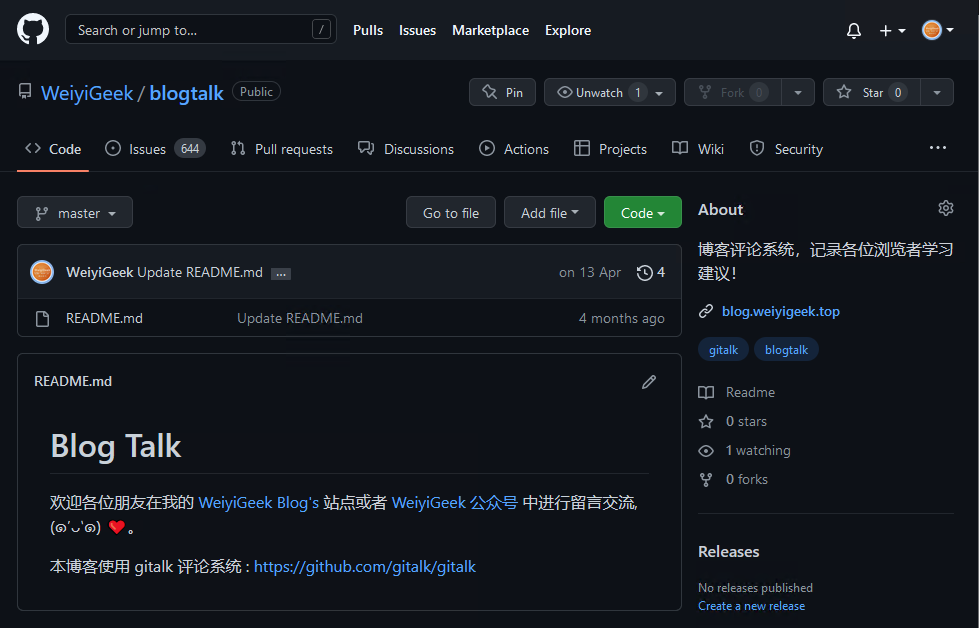
使用方式1.将如下代码添加到您的页面:
<head>
<link rel="stylesheet" href="https://cdn.jsdelivr.net/npm/gitalk@1/dist/gitalk.css">
<script src="https://cdn.jsdelivr.net/npm/gitalk@1/dist/gitalk.min.js"></script>
</head>
<body>
<div id="gitalk-container"></div>
<script>
const gitalk = new Gitalk({
clientID: 'GitHub Application Client ID', // 8d8e96********797026d3
clientSecret: 'GitHub Application Client Secret', // secrets**********secrets
repo: 'GitHub repo', // blogtalk
owner: 'GitHub repo owner', // WeiyiGeek
admin: ['GitHub repo owner and collaborators, only these guys can initialize github issues'], // ['WeiyiGeek']
id: location.pathname, // Ensure uniqueness and length less than 50
distractionFreeMode: false // Facebook-like distraction free mode
})
gitalk.render('gitalk-container')
</script>
</body>
使用方式2.在React中使用
import GitalkComponent from "gitalk/dist/gitalk-component";
// 并使用类似的组件
<GitalkComponent options={{
clientID: "...",
// ...
// options below
}} />
温馨提示: Gitalk 对象实例化参数参考 (https://github.com/gitalk/gitalk#options)
3.使用实践
在 Hexo 中使用
描述: 此处以我的博客[https://blog.weiyigeek.top] 为例进行演示配置,此处笔者使用的是 hexo + mellow 主题 , 已经经过二次魔改(有需要该博客主题请在公众号回复【mellow博客主题】或者访问 https://weiyigeek.top/wechat.html?key=mellow博客主题 )。
- Step 1.在 Hexo 主题中的 _config.yaml 配置加入如下配置片段。
# gittalk 评论系统
gitalk:
enable: true
owner: WeiyiGeek # github账号
repo: blogtalk # 留言仓库
proxy: /github/login/oauth/access_token # 反向代理解决跨域问题,后续将会主要讲解哦。
oauth:
client_id: 8d8e965c******97026d3 # Github App Auth ID
client_secret: e9c6141cb1f02f721********d01cb4d7a8f069 # Github App Auth secret
perPage: 15
- Step 2.在主题文档引擎中加入如下片段。
<div id="gitalk-container"></div>
<!-- 实际上是将 <script src="https://cdn.jsdelivr.net/npm/gitalk@1/dist/gitalk.min.js"></script> js 下载到了本地 -->
<script type="text/javascript" src="<%- url_for(theme_js('/js/plugins/gitalk.min', cache)) %>"></script>
<script type="text/javascript" src="<%- url_for(theme_js('/js/custom/gitalk.init', cache)) %>"></script>
<!-- themes\mellow\source\js\custom\gitalk.init.js -->
var gitalk = new Gitalk({
clientID: '<%- theme.gitalk.oauth.client_id %>',
clientSecret: '<%- theme.gitalk.oauth.client_secret %>',
repo: '<%- theme.gitalk.repo %>',
owner: '<%- theme.gitalk.owner %>',
admin: ['<%- theme.gitalk.owner %>'],
id: location.pathname,
proxy: '<%- theme.gitalk.proxy %>',
distractionFreeMode: true
})
# hexo g 生成静态文件后的样子
# var gitalk = new Gitalk({
# clientID: '8d8e965c******97026d3',
# clientSecret: 'e9c6141cb1f02f721********d01cb4d7a8f069',
# repo: 'blogtalk',
# owner: 'WeiyiGeek',
# admin: ['WeiyiGeek'],
# id: location.pathname,
# proxy: '/github/login/oauth/access_token',
# distractionFreeMode: false
# })
# 创建 gitalk-container
gitalk.render('gitalk-container')
温馨提示: 建议将distractionFreeMode设置为false,因为True真心难看。
温馨提示: 为了 Github Apps ID 与 Secrets 的安全,我们需要针对上面 new Gitalk 实例化参数进行js加密混淆 (http://www.esjson.com/jsEncrypt.html)
n.入坑出坑
1.使用Gitalk进行Github的Oauth认证无法跨域获取Token问题解决办法
描述: 在最开始之初我们也是使用官方演示代码中,使用的第三方提供的CORS代理服务,他会默认放行所有CORS请求,但是随着而来的问题是登陆会出现网络错误 Error: Network Error 或者在使用时出现 Forbidden 错误 (https://github.com/gitalk/gitalk/issues/514) 。
目前由于该CORS代理服务遭到滥用,因此做了限制,导致GitTalk失效,在实践中发现如下CORS代理服务其要么有限制要么根本不能使用,所以实践的朋友们就不要像使用如下CORS代理服务:
# 限流
https://cors-anywhere.herokuapp.com/https://github.com/login/oauth/access_token
# 被墙
https://cors-anywhere.azm.workers.dev/https://github.com/login/oauth/access_token
温馨提示: CORS Anywhere 是一个 NodeJS 代理,它将 CORS 标头添加到代理请求中。 项目地址 (https://github.com/Rob--W/cors-anywhere)
在 百度 CSDN 中捡了一圈垃圾之后,还是没有最好的解决方案,然后通过某种方式Google了一下,找到两种替代的方式利用cloudflare worker (不幸得是默认的cf worker的域名workers.dev被墙了)或者 Vercel 搭建在线代理(无vps推荐使用Vercel) 或者 使用VPS中的nginx服务器来反代 https://github.com (比较推荐-当前博主正在使用)。
方式1.没有VPS或者自己的服务器(想白嫖的)
描述: 在 cloudflare (https://dash.cloudflare.com/login/) 上创建一个免费的在线代理来解决gitalk授权登录跨域问题,利用CloudFlare Worker创建在线代理,不需要我们有服务器,也不需要搭建Node.js服务,只需要注册一个CloudFlare账号,创建一个Worker,部署一个JS脚本就可以了,简单方便,下面我们就来看看如何创建吧。
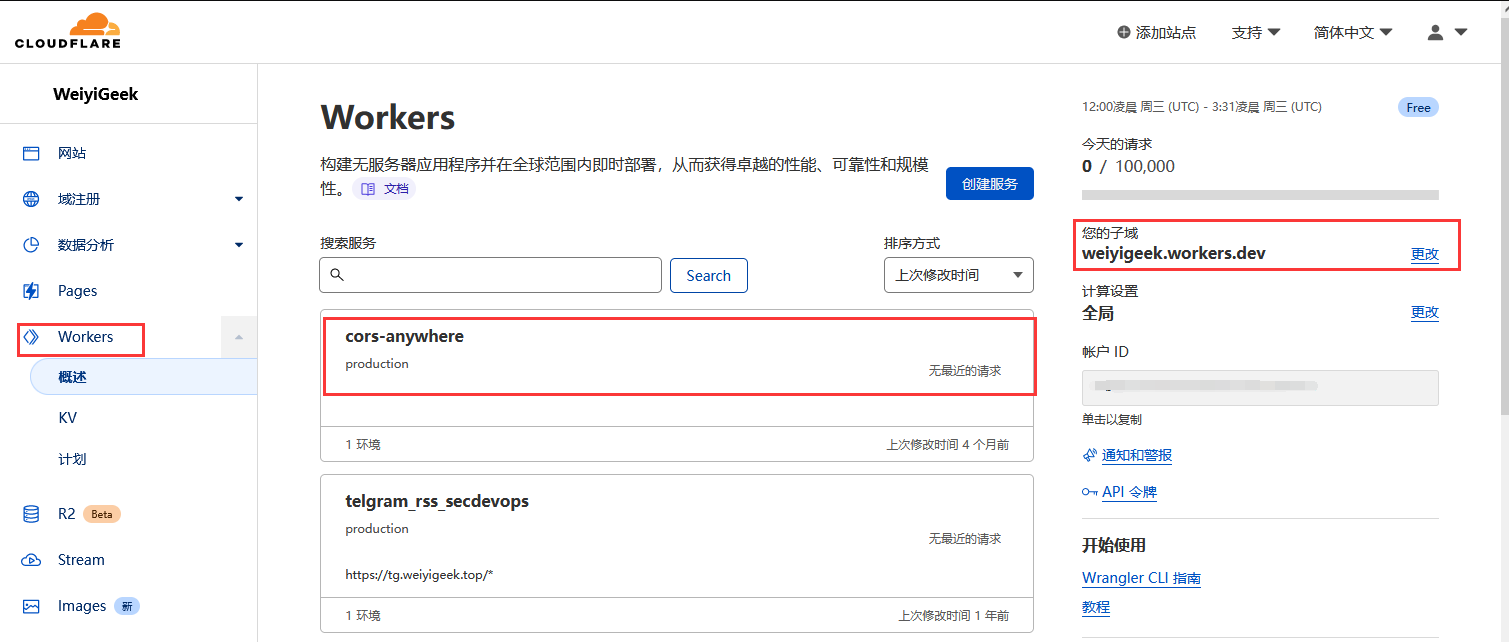
创建好之后我们便可编辑其 Worker 服务代码,如下代码也可通过 https://github.com/WeiyiGeek/SecOpsDev/tree/master/Application/Blog/Hexo/Gitalk 获得。
const exclude = []; // Regexp for blacklisted urls
const include = [/^https?:\/\/.*weiyigeek\.top$/, /^https?:\/\/localhost/]; // Regexp for whitelisted origins e.g.
const apiKeys = {
EZWTLwVEqFnaycMzdhBz: {
name: 'Test App',
expired: false,
expiresAt: new Date('2023-01-01'),
exclude: [], // Regexp for blacklisted urls
include: ["^http.?://www.weiyigeek.top$", "weiyigeek.top$", "^https?://localhost/"], // Regexp for whitelisted origins
},
};
// Config is all above this line.
// It should not be necessary to change anything below.
function verifyCredentials(request) {
// Throws exception on verification failure.
const requestApiKey = request.headers.get('x-cors-proxy-api-key');
if (!Object.keys(apiKeys).includes(requestApiKey)) {
throw new UnauthorizedException('Invalid authorization key.');
}
if (apiKeys[requestApiKey].expired) {
throw new UnauthorizedException('Expired authorization key.');
}
if (apiKeys[requestApiKey].expiresAt && apiKeys[requestApiKey].expiresAt.getTime() < Date.now()) {
throw new UnauthorizedException(`Expired authorization key.\nKey was valid until: ${apiKeys[requestApiKey].expiresAt}`);
}
return apiKeys[requestApiKey];
}
function checkRequiredHeadersPresent(request) {
// Throws exception on verification failure.
if (!request.headers.get('Origin') && !request.headers.get('x-requested-with')) {
throw new BadRequestException('Missing required request header. Must specify one of: origin,x-requested-with');
}
}
function UnauthorizedException(reason) {
this.status = 401;
this.statusText = 'Unauthorized';
this.reason = reason;
}
function BadRequestException(reason) {
this.status = 400;
this.statusText = 'Bad Request';
this.reason = reason;
}
function isListed(uri, listing) {
let returnValue = false;
console.log(uri);
if (typeof uri === 'string') {
for (const m of listing) {
if (uri.match(m) !== null) {
returnValue = true;
}
}
} else { // Decide what to do when Origin is null
returnValue = true; // True accepts null origins false rejects them.
}
return returnValue;
}
function fix(myHeaders, request, isOPTIONS) {
myHeaders.set('Access-Control-Allow-Origin', request.headers.get('Origin'));
if (isOPTIONS) {
myHeaders.set('Access-Control-Allow-Methods', request.headers.get('access-control-request-method'));
const acrh = request.headers.get('access-control-request-headers');
if (acrh) {
myHeaders.set('Access-Control-Allow-Headers', acrh);
}
myHeaders.delete('X-Content-Type-Options');
}
return myHeaders;
}
function parseURL(requestUrl) {
const match = requestUrl.match(/^(?:(https?:)?\/\/)?(([^/?]+?)(?::(\d{0,5})(?=[/?]|$))?)([/?][\S\s]*|$)/i);
// ^^^^^^^ ^^^^^^^^ ^^^^^^^ ^^^^^^^^^^^^
// 1:protocol 3:hostname 4:port 5:path + query string
// ^^^^^^^^^^^^^^^^^^^^^^^^^^^^^^^^^^^^
// 2:host
if (!match) {
console.log('no match');
throw new BadRequestException('Invalid URL for proxy request.');
}
console.log('parseURL:match:', match);
if (!match[1]) {
console.log('nothing in match group 1');
if (/^https?:/i.test(requestUrl)) {
console.log('The pattern at top could mistakenly parse "http:///" as host="http:" and path=///.');
throw new BadRequestException('Invalid URL for proxy request.');
}
// Scheme is omitted.
if (requestUrl.lastIndexOf('//', 0) === -1) {
console.log('"//" is omitted');
requestUrl = '//' + requestUrl;
}
requestUrl = (match[4] === '443' ? 'https:' : 'http:') + requestUrl;
}
const parsed = new URL(requestUrl);
if (!parsed.hostname) {
console.log('"http://:1/" and "http:/notenoughslashes" could end up here.');
throw new BadRequestException('Invalid URL for proxy request.');
}
return parsed;
}
async function proxyRequest(request, activeApiKey) {
const isOPTIONS = (request.method === 'OPTIONS');
const originUrl = new URL(request.url);
const origin = request.headers.get('Origin');
// ParseURL throws when the url is invalid
const fetchUrl = parseURL(request.url.replace(originUrl.origin, '').slice(1));
// Throws if it fails the check
checkRequiredHeadersPresent(request);
// Excluding urls which are not allowed as destination urls
// Exclude origins which are not int he included ones
if (isListed(fetchUrl.toString(), [...exclude, ...(activeApiKey?.exclude || [])]) || !isListed(origin, [...include, ...(activeApiKey?.include || [])])) {
throw new BadRequestException('Origin or Destination URL is not allowed.');
}
let corsHeaders = request.headers.get('x-cors-headers');
if (corsHeaders !== null) {
try {
corsHeaders = JSON.parse(corsHeaders);
} catch {}
}
if (!originUrl.pathname.startsWith('/')) {
throw new BadRequestException('Pathname does not start with "/"');
}
const recvHpaireaders = {};
for (const pair of request.headers.entries()) {
if ((pair[0].match('^origin') === null)
&& (pair[0].match('eferer') === null)
&& (pair[0].match('^cf-') === null)
&& (pair[0].match('^x-forw') === null)
&& (pair[0].match('^x-cors-headers') === null)
) {
recvHpaireaders[pair[0]] = pair[1];
}
}
if (corsHeaders !== null) {
for (const c of Object.entries(corsHeaders)) {
recvHpaireaders[c[0]] = c[1];
}
}
const newRequest = new Request(request, {
headers: recvHpaireaders,
});
const response = await fetch(fetchUrl, newRequest);
let myHeaders = new Headers(response.headers);
const newCorsHeaders = [];
const allh = {};
for (const pair of response.headers.entries()) {
newCorsHeaders.push(pair[0]);
allh[pair[0]] = pair[1];
}
newCorsHeaders.push('cors-received-headers');
myHeaders = fix(myHeaders, request, isOPTIONS);
myHeaders.set('Access-Control-Expose-Headers', newCorsHeaders.join(','));
myHeaders.set('cors-received-headers', JSON.stringify(allh));
const body = isOPTIONS ? null : await response.arrayBuffer();
return new Response(body, {
headers: myHeaders,
status: (isOPTIONS ? 200 : response.status),
statusText: (isOPTIONS ? 'OK' : response.statusText),
});
}
function homeRequest(request) {
const isOPTIONS = (request.method === 'OPTIONS');
const originUrl = new URL(request.url);
const origin = request.headers.get('Origin');
const remIp = request.headers.get('CF-Connecting-IP');
const corsHeaders = request.headers.get('x-cors-headers');
let myHeaders = new Headers();
myHeaders = fix(myHeaders, request, isOPTIONS);
let country = false;
let colo = false;
if (typeof request.cf !== 'undefined') {
country = typeof request.cf.country === 'undefined' ? false : request.cf.country;
colo = typeof request.cf.colo === 'undefined' ? false : request.cf.colo;
}
return new Response(
'CLOUDFLARE-CORS-ANYWHERE\n\n'
+ 'Source:\nhttps://github.com/chrisspiegl/cloudflare-cors-anywhere\n\n'
+ 'Usage:\n'
+ originUrl.origin + '/{uri}\n'
+ 'Header x-cors-proxy-api-key must be set with valid api key\n'
+ 'Header origin or x-requested-with must be set\n\n'
// + 'Limits: 100,000 requests/day\n'
// + ' 1,000 requests/10 minutes\n\n'
+ (origin === null ? '' : 'Origin: ' + origin + '\n')
+ 'Ip: ' + remIp + '\n'
+ (country ? 'Country: ' + country + '\n' : '')
+ (colo ? 'Datacenter: ' + colo + '\n' : '') + '\n'
+ ((corsHeaders === null) ? '' : '\nx-cors-headers: ' + JSON.stringify(corsHeaders)),
{status: 200, headers: myHeaders},
);
}
async function handleRequest(request) {
const {protocol, pathname} = new URL(request.url);
// In the case of a "Basic" authentication, the exchange MUST happen over an HTTPS (TLS) connection to be secure.
if (protocol !== 'https:' || request.headers.get('x-forwarded-proto') !== 'https') {
throw new BadRequestException('Must use a HTTPS connection.');
}
switch (pathname) {
case '/favicon.ico':
case '/robots.txt':
return new Response(null, {status: 204});
case '/':
return homeRequest(request);
default: {
// Not 100% sure if this is a good idea…
// Right now all OPTIONS requests are just simply replied to because otherwise they fail.
// This is necessary because apparently, OPTIONS requests do not carry the `x-cors-proxy-api-key` header so this can not be authorized.
if (request.method === 'OPTIONS') {
return new Response(null, {
headers: fix(new Headers(), request, true),
status: 200,
statusText: 'OK',
});
}
// The "x-cors-proxy-api-key" header is sent when authenticated.
//if (request.headers.has('x-cors-proxy-api-key')) {
// Throws exception when authorization fails.
//const activeApiKey = verifyCredentials(request);
// Only returns this response when no exception is thrown.
return proxyRequest(request);
//}
// Not authenticated.
//throw new UnauthorizedException('Valid x-cors-proxy-api-key header has to be provided.');
}
}
}
addEventListener('fetch', async event => {
event.respondWith(
handleRequest(event.request).catch(error => {
const message = error.reason || error.stack || 'Unknown Error';
return new Response(message, {
status: error.status || 500,
statusText: error.statusText || null,
headers: {
'Content-Type': 'text/plain;charset=UTF-8',
// Disables caching by default.
'Cache-Control': 'no-store',
// Returns the "Content-Length" header for HTTP HEAD requests.
'Content-Length': message.length,
},
});
}),
);
});
部署结果: https://cors-anywhere.weiyigeek.workers.dev/
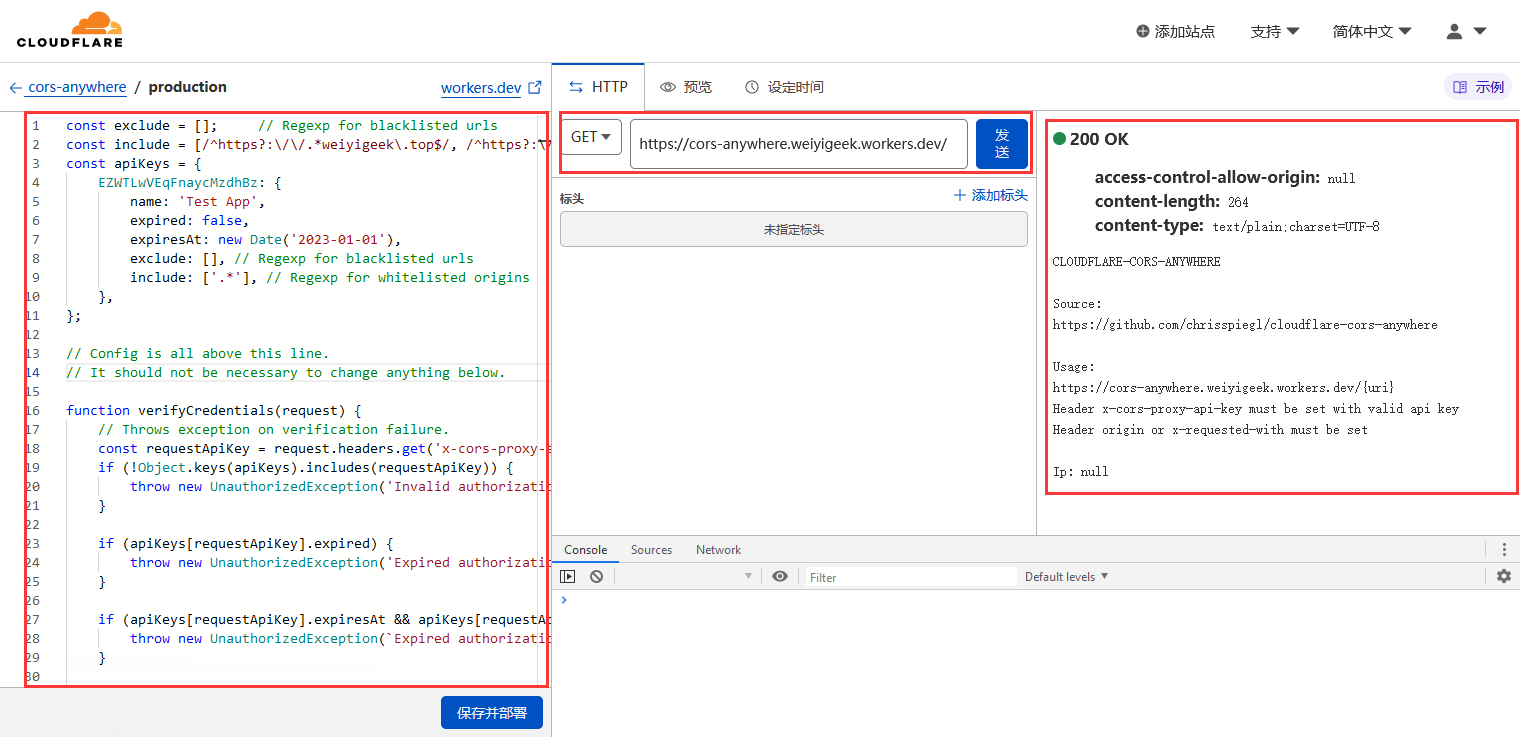
温馨提示: cloudflare 构建无服务器应用程序免费版本每天限额10万次请求,所有为了避免其它 people 恶意使用,请在使用时设置访问白名单, 上述源码来源于 (https://github.com/chrisspiegl/cloudflare-cors-anywhere)。
温馨提示: 除了使用 cloudflare 还可以使用 Vercel 免费部署node.js项目解决跨域问题,你可参考该项目 (https://github.com/Dedicatus546/cors-server) ,此处就不在累述。
方式2.有公网VPS、服务器
描述: 由于我自己有VPS所以就不借用 cloudflare 与 Vercel,因为其国内网络原因,时而通畅时而有缓慢 , 此处我将使用Nginx服务在blog.conf配置Nginx文件中加入如下location指令片段
# https - www.weiyigeek.top
server {
listen 80;
listen 443 ssl http2;
server_name blog.weiyigeek.top;
# CORS
add_header Access-Control-Allow-Origin '*.weiyigeek.top';
add_header Access-Control-Allow-Methods 'GET,POST,OPTIONS';
add_header Access-Control-Allow-Headers 'DNT,X-Mx-ReqToken,Keep-Alive,User-Agent,X-Requested-With,If-Modified-Since,Cache-Control,Content-Type,Authorization';
...
# Gitalk Auth Use
location /github {
if ($request_method = 'OPTIONS') {
return 204;
}
proxy_pass https://github.com/; # 注意尾部斜杠不能少
}
...
error_page 403 /warn/403.html;
error_page 404 /warn/404.html;
error_page 500 502 503 /warn/500.html;
error_page 504 /warn/504.html;
}
配置完成后检测blog.conf配置以及重载nginx服务 nginx -t && nginx -s reload, 然后修改Hexo 主题中的 _config.yaml 将 Gitalk 的 proxy 配置为 proxy: /github/login/oauth/access_token 即可。
# gittalk 评论系统
gitalk:
enable: true
owner: WeiyiGeek # github账号
repo: blogtalk # 留言仓库
proxy: /github/login/oauth/access_token # 关键点 (前台请求是https://blog.weiyigeek.top/github/login/oauth/access_token, 而实际请求是https://github.com/login/oauth/access_token,所以解决了跨域问题)
oauth:
client_id: 8d8e965c******97026d3 # Github App Auth ID
client_secret: e9c6141cb1f02f721********d01cb4d7a8f069 # Github App Auth secret
perPage: 15
之后,我们需要批量初始每篇文章issue根据其路径/2020/3-20-658.html,此处采用了gitalk-auto-init.js脚本进行批量初始化文章issue。
温馨提示: 下述 gitalk-auto-init.js 脚本可以通过如下连接( https://github.com/WeiyiGeek/SecOpsDev/tree/master/Application/Blog/Hexo/Gitalk )进行获取
脚本依赖:
$ npm i -S hexo-generator-sitemap
$ npm i -D md5 moment request xml-parser
+ moment@2.29.2
+ request@2.88.2
+ md5@2.3.0
+ xml-parser@1.2.1
added 55 packages from 70 contributors in 8.467s
配置运行:
// gitalk-auto-init.js 脚本部分片段
// 配置信息
const config = {
username: 'weiyigeek', // GitHub repository 所有者,可以是个人或者组织。对应Gitalk配置中的owner
repo: "blogtalk", // 储存评论issue的github仓库名,仅需要仓库名字即可。对应 Gitalk配置中的repo
token: 'ghp_wnpWqL********6RIf0NR5iD', // 前面在Github中的 personal access token
sitemap: path.join(__dirname, './public/sitemap.xml'), // 自己站点的 sitemap 文件地址
cache: true, // 是否启用缓存,启用缓存会将已经初始化的数据写入配置的 gitalkCacheFile 文件,下一次直接通过缓存文件判断
gitalkCacheFile: path.join(__dirname, './gitalk-init-cache.json'), // 用于保存 gitalk 已经初始化的 id 列表
gitalkErrorFile: path.join(__dirname, './gitalk-init-error.json'), // 用于保存 gitalk 初始化报错的数据
};
// sitemap.xml 示例
<?xml version="1.0" encoding="UTF-8"?>
<urlset xmlns="http://www.sitemaps.org/schemas/sitemap/0.9">
<url>
<loc>https://blog.weiyigeek.top/2020/5-28-588.html</loc>
<lastmod>2022-08-15T14:39:08.638Z</lastmod>
<title>Ingress-Nginx进阶学习实践扩充配置记录</title>
</url>
....
</urlset>
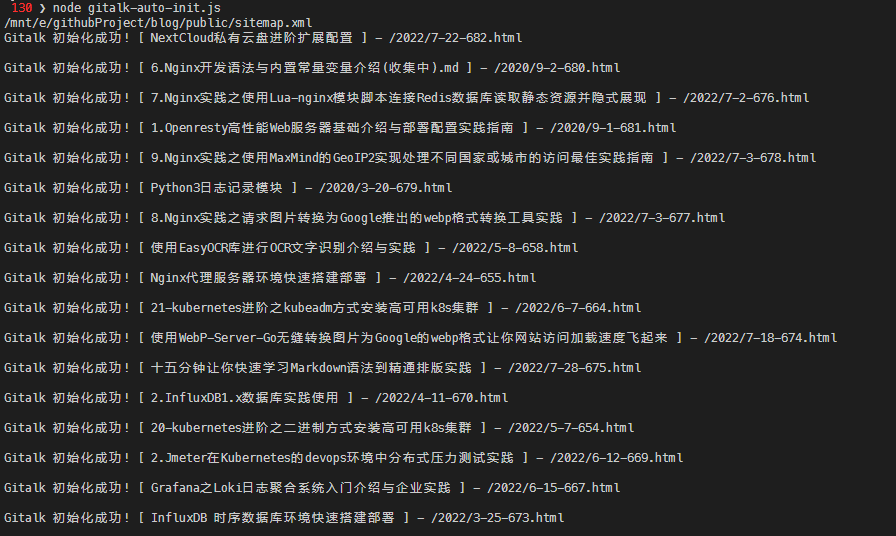
执行结果:
--------- 运行结果 ---------
报错数据: 1 条。参考文件 /mnt/e/githubProject/blog/gitalk-init-error.json。
本次成功: 27 条。
写入缓存: 90 条,已初始化 63 条,本次成功: 27 条。参考文件 /mnt/e/githubProject/blog/gitalk-init-cache.json。
我们也可以通过 blogtalk 项目中 issue (https://github.com/WeiyiGeek/blogtalk/issues) 查看初始化结果以及最新评论。
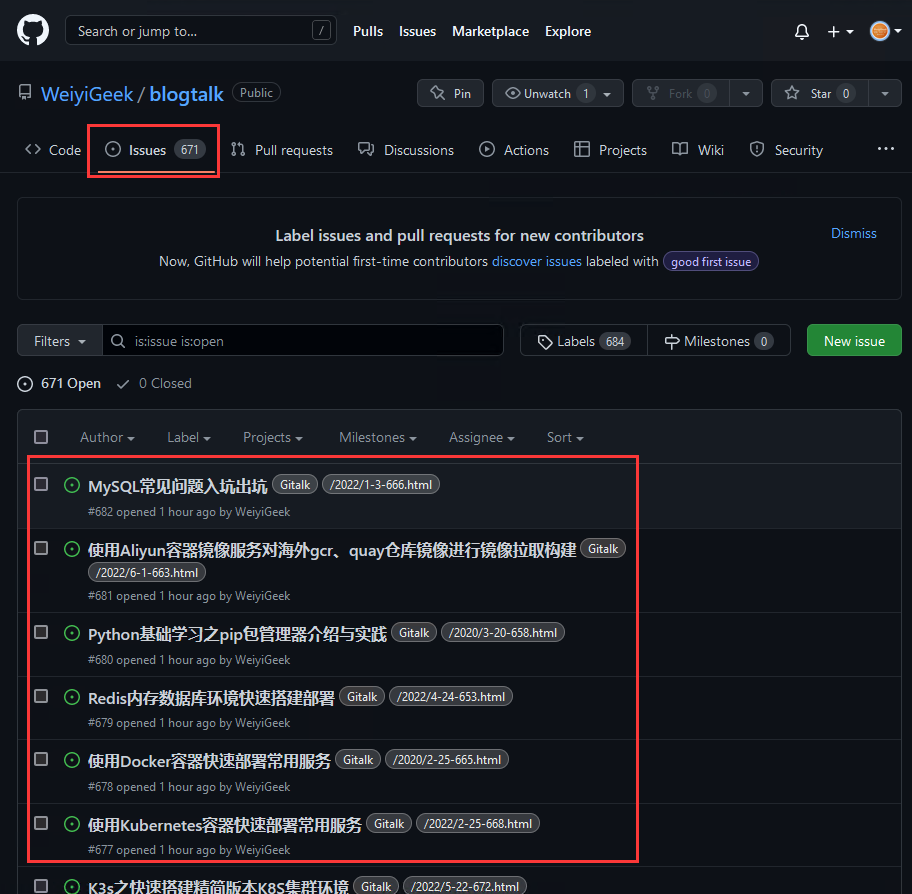
在初始化issue完成之后,我们可以找到一篇 https://blog.weiyigeek.top/about/ 文章进行留言验证。
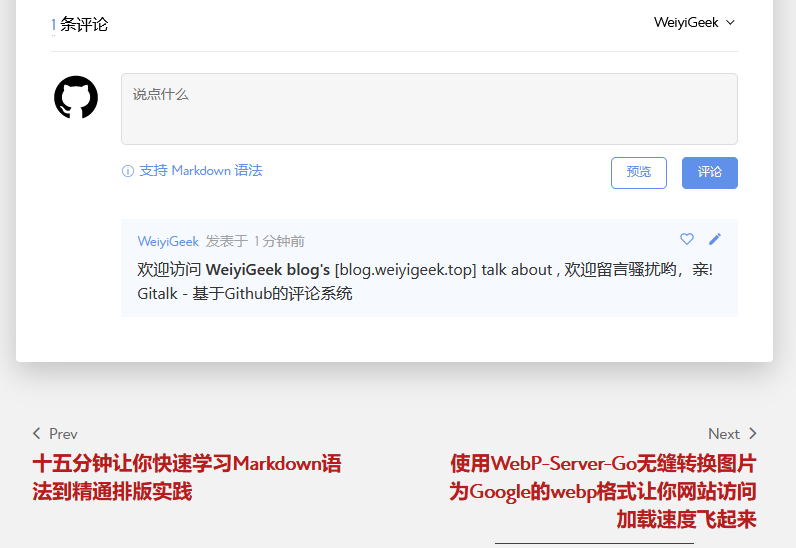
原文地址: https://blog.weiyigeek.top/2022/5-28-588.html
本文至此完毕,更多技术文章,尽情期待下一章节!
【WeiyiGeek Blog 个人博客 - 为了能到远方,脚下的每一步都不能少 】
欢迎各位志同道合的朋友一起学习交流【点击加入交流群】,如文章有误请在下方留下您宝贵的经验知识!
作者主页: 【 https://weiyigeek.top】
博客地址: 【 https://blog.weiyigeek.top 】
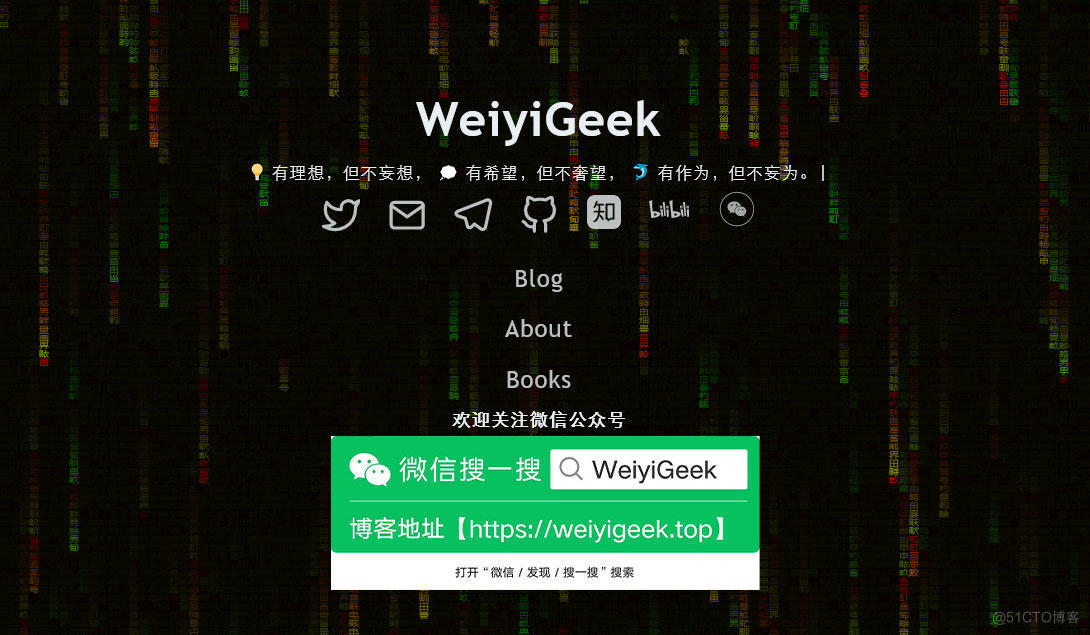
专栏书写不易,如果您觉得这个专栏还不错的,请给这篇专栏 【点个赞、投个币、收个藏、关个注,转个发,留个言】(人间六大情),这将对我的肯定,谢谢!。
-
echo "【点个赞】,动动你那粗壮的拇指或者芊芊玉手,亲!"
-
printf("%s", "【投个币】,万水千山总是情,投个硬币行不行,亲!")
-
fmt.Printf("【收个藏】,阅后即焚不吃灰,亲!")
-
console.info("【转个发】,让更多的志同道合的朋友一起学习交流,亲!")
-
System.out.println("【关个注】,后续浏览查看不迷路哟,亲!")
-
cout << "【留个言】,文章写得好不好、有没有错误,一定要留言哟,亲! " << endl;

更多网络安全、系统运维、应用开发、物联网实践、网络工程、全栈文章,尽在 https://blog.weiyigeek.top 之中,谢谢各位看又支持!
本文来自博客园,作者:全栈工程师修炼指南,转载请注明原文链接:https://www.cnblogs.com/WeiyiGeek/p/16597538.html。
欢迎关注博主【WeiyiGeek】公众号以及【极客全栈修炼】小程序



 我想对于所有使用hexo、Hugo或者WordPress自建博客的博主来说GitTalk应该不陌生,GitTalk通过Github的OpenAPI以及issues功能实现社区评论确实还是很方便的,除开对国内访问速度较慢就没啥毛病,但是考虑到新手朋友此处还是简单介绍一下。
我想对于所有使用hexo、Hugo或者WordPress自建博客的博主来说GitTalk应该不陌生,GitTalk通过Github的OpenAPI以及issues功能实现社区评论确实还是很方便的,除开对国内访问速度较慢就没啥毛病,但是考虑到新手朋友此处还是简单介绍一下。




【推荐】国内首个AI IDE,深度理解中文开发场景,立即下载体验Trae
【推荐】编程新体验,更懂你的AI,立即体验豆包MarsCode编程助手
【推荐】抖音旗下AI助手豆包,你的智能百科全书,全免费不限次数
【推荐】轻量又高性能的 SSH 工具 IShell:AI 加持,快人一步
· 分享一个免费、快速、无限量使用的满血 DeepSeek R1 模型,支持深度思考和联网搜索!
· 使用C#创建一个MCP客户端
· 基于 Docker 搭建 FRP 内网穿透开源项目(很简单哒)
· ollama系列1:轻松3步本地部署deepseek,普通电脑可用
· 按钮权限的设计及实现